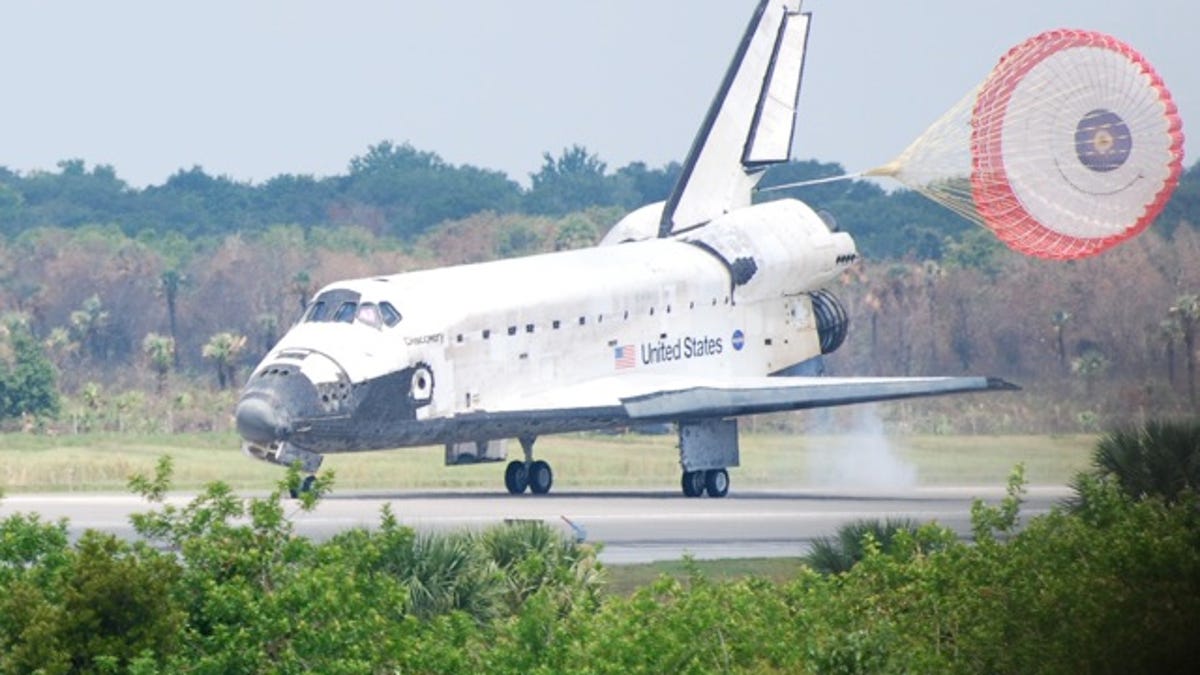Space Shuttle Discovery lands flawlessly
With a touchdown at Kennedy Space Center, the latest shuttle mission is over after 5.7 million miles of flight to the International Space Station.

KENNEDY SPACE CENTER, Fla.--Discovery has returned.
With a puff of smoke from its wheels touching down on runway 1-5 here, the space shuttle completed its 5.7 million mile mission Saturday at precisely 11:15 a.m. and 19 seconds EDT to the cheers of a crowd gathered to watch it land.
For the most part, it was an uneventful arrival, if you can call something like this uneventful.
For me, visiting Kennedy Space Center (KSC) on my Road Trip 2008 through the South, it was a wonderful experience. I knew I was coming here when I planned the journey and had hoped to make it to the launch on May 31. But hey, landings are important, too.
The day began with a little bit of uncertainty as to whether the landing could go off as planned. Not that anything was wrong, but the way these things go, the green light isn't given until about an hour and a half before the scheduled return.
In the case of Discovery, the thumbs-up was broadcast at 9:48 a.m. EDT, an hour and 27 minutes before planned touchdown.
From that point on, it was just a matter of waiting as the shuttle made its way down from space, a place rather higher than the sea level ground here at KSC.
In the interim, the gathered crowd--dignitaries, press, NASA personnel, and others--were treated to regular updates over loudspeakers from mission control in Houston. Things like new data on how high the shuttle was, or how fast it was going, or its rate of descent.

It turns out the shuttle moves really fast. Like more than 25 times the speed of sound on its return to Earth.
While I'm sure there were never any safety concerns about Discovery, this is not the best-looking aircraft. As it passed us by on the runway, I noticed that it looked pretty beat up. It's just survived the rigors of millions of miles of space travel, but still.
As a fellow reporter back in the press building noted, "If that was your plane on Continental, you wouldn't get on it."
But that's just quibbling. This was, by all accounts, a perfectly normal mission that launched on time and returned on time.
Given that most commercial airlines can't be bothered to maintain that track record, you have to give NASA a nod for its punctuality.
Afterward, the shuttle sat on the runway and was approached by a 40-vehicle convoy tasked with getting the crew out of the aircraft and bringing the mission to a close (see video below).
Of course, the mission, known as STS-124, did have some practical responsibilities.
Among them were delivering the pressurized module and robotic arm of the Japanese Experiment Module, known as "Kibo" (which means "hope"), to the International Space Station.
The shuttle was piloted by Navy Commander Kenneth Ham. Other mission specialists onboard were NASA astronaut Karen Nyberg; Air Force Col. Ronald Garan; and Air Force Reserve Col. Michael Fossum. In addition, Japan Aerospace Exploration Agency (JAXA) astronaut Akihiko Hoshide joined the mission as a specialist.
Further, the mission was about depositing astronaut Gregory Chamitoff on the Space Station. Chamitoff took the place of Garrett Reisman.
Now, as NASA prepares to move into the Constellation program, the shuttle is one mission closer to retirement. With just nine missions left until the 2010 end of the program, every opportunity to see something like Discovery's landing is a rare opportunity, indeed.

